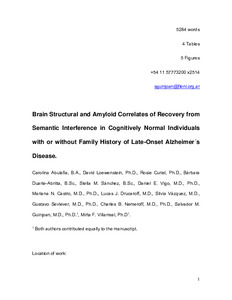Por favor, use este identificador para citar o enlazar este ítem:
https://repositorio.uca.edu.ar/handle/123456789/1437| Título: | Brain structural and amyloid correlates of recovery from semantic interference in cognitively normal individuals with or without gamily history of late-onset Alzheimer's disease | Autor: | Abulafia, Carolina Andrea Loewenstein, David A. Curiel-Cid, Rosie Duarte-Abritta, Bárbara Sánchez, Stella M. Vigo, Daniel Eduardo Castro, Mariana N. Drucaroff, Lucas J. Vázquez, Silvia Sevlever, Gustavo Nemeroff, Charles B. Guinjoan, Salvador M. Villareal, Mirta F. |
Palabras clave: | MEDICINA; ENFERMEDAD DE ALZHEIMER; MEMORIA | Fecha de publicación: | 2019 | Editorial: | American Psychiatric Association | Cita: | Abulafia, C., et al. Brain structural and amyloid correlates of recovery from semantic interference in cognitively normal individuals with or without gamily history of late-onset Alzheimer's disease [en línea]. Postprint del artículo publicado en The Journal of Neuropsychiatry and Clinical Neurosciences. 2019, 31 (1). doi:10.1176/appi.neuropsych.17120355. Disponible en: https://repositorio.uca.edu.ar/handle/123456789/1437 | Resumen: | Abstract: Failure to recover from proactive semantic interference (frPSI) has been shown to be more sensitive than traditional cognitive measures in different populations with preclinical Alzheimer’s disease. The authors sought to characterize the structural and amyloid in vivo correlates of frPSI in cognitively normal offspring of patients with late-onset Alzheimer’s disease (O-LOAD), compared with individuals without a family history of neurodegenerative disorders (CS). The authors evaluated the LASSI-L, a test tapping frPSI and other types of semantic interference and delayed recall on the RAVLT, along with 3-T MRI volumetry and positron emission tomography Pittsburgh compound B, in 27 O-LOAD and 18 CS with equivalent age, sex, years of education, ethnicity, premorbid intelligence, and mood symptoms. Recovery from proactive semantic interference (frPSI) and RAVLT delayed recall were lower in O-LOAD cases. Structural correlates of both cognitive dimensions were different in CS and O-LOAD, involving brain regions concerned with autonomic, motor, and motivational control in the former, and regions traditionally implicated in Alzheimer’s disease in the latter. Better recovery from retroactive semantic interference was associated with less amyloid load in the left temporal lobe in O-LOAD but not CS. In middle-aged cognitively normal individuals with one parent affected with LOAD, frPSI was impaired compared with persons without a family history of LOAD. The neuroimaging correlates of such cognitive measure in those with one parent with LOAD involve Alzheimer’s-relevant brain regions even at a relatively young age. | URI: | https://repositorio.uca.edu.ar/handle/123456789/1437 | ISSN: | 1545-7222 (online) | Disciplina: | MEDICINA | DOI: | 10.1176/appi.neuropsych.17120355 | Derechos: | Acceso Abierto. 1 año de embargo | Fuente: | Postprint de artículo publicado en The Journal of Neuropsychiatry and Clinical Neurosciences. 2019, 31 (1) |
| Aparece en las colecciones: | Artículos |
Ficheros en este ítem:
| Fichero | Descripción | Tamaño | Formato | |
|---|---|---|---|---|
| brain-structural-amyloid-correlates.pdf | 1,02 MB | Adobe PDF |  Visualizar/Abrir |
Visualizaciones de página(s)
180
comprobado en 30-abr-2024
Descarga(s)
150
comprobado en 30-abr-2024
Google ScholarTM
Ver en Google Scholar
Altmetric
Altmetric
Este ítem está sujeto a una Licencia Creative Commons

